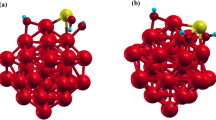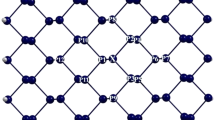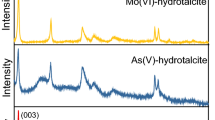Abstract
The applicability of the black phosphorus monolayer (BPML) material to remove cadmium, lead, mercury, and arsenic ions from contaminated environments was evaluated. The coordination of metal ion varied from two to four. Both expanding and contracting distortions were observed. The bandgap of BPML was enlarged by 0.12–1.10 eV, with the smallest and largest changes for Pb (II) and Hg (II), respectively. After decoration, all decorated BPML nanosheets kept their p-type semiconducting property. The total density of states (TDOS) plots indicated the marked impact of the adatoms on the Fermi level of BPML. The considerably high adsorption energies followed the sequence of Pb (II) < Cd (II) < Hg (II) << As (III), in full correspondence with the remarkable charge transfers (0.440–1.236 e). The localized orbital locator (LOL) profiles revealed the nature of the interactions.






Similar content being viewed by others
References
Ghashghaee M, Farzaneh V (2016) Removal of Cr (VI) species from aqueous solution by different nanoporous materials. Iran J Toxicol 10(6):15–21
Jiang K, Sun T-h, Sun L-n, Li H-b (2006) Adsorption characteristics of copper, lead, zinc and cadmium ions by tourmaline. J Environ Sci 18(6):1221–1225. https://doi.org/10.1016/S1001-0742(06)60066-1
Lukman S, Essa MH, Mu’azu ND, Bukhari A, Basheer C (2013) Adsorption and desorption of heavy metals onto natural clay material: influence of initial pH. J Environ Sci Technol 6(1):1–15. https://doi.org/10.3923/jest.2013.1.15
Perić J, Trgo M, Vukojević Medvidović N (2004) Removal of zinc, copper and lead by natural zeolite—a comparison of adsorption isotherms. Water Res 38(7):1893–1899. https://doi.org/10.1016/j.watres.2003.12.035
Northcott K, Kokusen H, Komatsu Y, Stevens G (2006) Synthesis and surface modification of mesoporous silicate SBA-15 for the adsorption of metal ions. Sep Sci Technol 41(9):1829–1840. https://doi.org/10.1080/01496390600725760
Pandey A, Bera D, Shukla A, Ray L (2007) Studies on Cr (VI), Pb (II) and Cu (II) adsorption–desorption using calcium alginate as biopolymer. Chem Speciat Bioavailab 19(1):17–24. https://doi.org/10.3184/095422907x198031
Tashauoei HR, Movahedian Attar H, Kamali M, Amin MM, Nikaeen M (2010) Removal of hexavalent chromium (VI) from aqueous solutions using surface modified nanozeolite A. Int J Environ Res 4(3):491–500. https://doi.org/10.22059/ijer.2010.234
Gaikwad RW, Gupta DV (2008) Review on removal of heavy metals from acid mine drainage. Appl Ecol Environ Res 6(3):81–89
Mishra SP (2014) Adsorption–desorption of heavy metal ions. Curr Sci 107(4):1133–1148
Castellanos-Gomez A, Vicarelli L, Prada E, Island JO, Narasimha-Acharya KL, Blanter SI, Groenendijk DJ, Buscema M, Steele GA, Alvarez JV, Zandbergen HW, Palacios JJ, van der Zant HSJ (2014) Isolation and characterization of few-layer black phosphorus. 2D Mater 1(2):025001. https://doi.org/10.1088/2053-1583/1/2/025001
Jing Y, Zhang X, Zhou Z (2016) Phosphorene: what can we know from computations? WIREs Comput Mol Sci 6(1):5–19. https://doi.org/10.1002/wcms.1234
Sorkin V, Cai Y, Ong Z, Zhang G, Zhang YW (2017) Recent advances in the study of phosphorene and its nanostructures. Crit Rev Solid State Mater Sci 42(1):1–82. https://doi.org/10.1080/10408436.2016.1182469
Lalitha M, Nataraj Y, Lakshmipathi S (2016) Calcium decorated and doped phosphorene for gas adsorption. Appl Surf Sci 377(Supplement C):311–323. https://doi.org/10.1016/j.apsusc.2016.03.119
Eswaraiah V, Zeng Q, Long Y, Liu Z (2016) Black phosphorus nanosheets: synthesis, characterization and applications. Small 12(26):3480–3502. https://doi.org/10.1002/smll.201600032
Dai J, Zeng XC (2014) Bilayer phosphorene: effect of stacking order on bandgap and its potential applications in thin-film solar cells. J Phys Chem Lett 5(7):1289–1293. https://doi.org/10.1021/jz500409m
Kou L, Frauenheim T, Chen C (2014) Phosphorene as a superior gas sensor: selective adsorption and distinct I–V response. J Phys Chem Lett 5(15):2675–2681. https://doi.org/10.1021/jz501188k
Kulish VV, Malyi OI, Persson C, Wu P (2015) Adsorption of metal adatoms on single-layer phosphorene. Phys Chem Chem Phys 17(2):992–1000. https://doi.org/10.1039/c4cp03890h
Li P, Zhang D, Jiang C, Zong X, Cao Y (2017) Ultra-sensitive suspended atomically thin-layered black phosphorus mercury sensors. Biosens Bioelectron 98:68–75. https://doi.org/10.1016/j.bios.2017.06.027
Li P, Zhang D, Liu J, Chang H, Sun Y, Yin N (2015) Air-stable black phosphorus devices for ion sensing. ACS Appl Mater Interfaces 7(44):24396–24402. https://doi.org/10.1021/acsami.5b07712
Abbas AN, Liu B, Chen L, Ma Y, Cong S, Aroonyadet N, Köpf M, Nilges T, Zhou C (2015) Black phosphorus gas sensors. ACS Nano 9(5):5618–5624. https://doi.org/10.1021/acsnano.5b01961
Yang AJ, Wang DW, Wang XH, Chu JF, Lv PL, Liu Y, Rong MZ (2017) Phosphorene: a promising candidate for highly sensitive and selective SF6 decomposition gas sensors. IEEE Electr Device Lett 38(7):963–966. https://doi.org/10.1109/led.2017.2701642
Liu C, Sun Z, Zhang L, Lv J, Yu XF, Chen X (2017) Black phosphorus integrated tilted fiber grating for ultrasensitive heavy metal sensing. Sensor Actuat B-Chem. https://doi.org/10.1016/j.snb.2017.11.022
Lange S, Schmidt P, Nilges T (2007) Au3SnP7@black phosphorus: an easy access to black phosphorus. Inorg Chem 46(10):4028–4035. https://doi.org/10.1021/ic062192q
Ghambarian M, Azizi Z, Ghashghaee M (2017) Cluster modeling and coordination structures of Cu+ ions in Al-incorporated Cu-MEL catalysts – a density functional theory study. J Mex Chem Soc 61(1):1–13. https://doi.org/10.29356/jmcs.v61i1.122
Ghambarian M, Ghashghaee M, Azizi Z (2017) Coordination and siting of Cu+ ion adsorbed into silicalite-2 porous structure: a density functional theory study. Phys Chem Res 5(1):135–152. https://doi.org/10.22036/pcr.2017.39255
Ghashghaee M, Ghambarian M, Azizi Z (2016) Characterization of extraframework Zn2+ cationic sites in silicalite-2: a computational study. Struct Chem 27(2):467–475. https://doi.org/10.1007/s11224-015-0575-y
Valiev M, Bylaska EJ, Govind N, Kowalski K, Straatsma TP, Van Dam HJJ, Wang D, Nieplocha J, Apra E, Windus TL, de Jong WA (2010) NWChem: a comprehensive and scalable open-source solution for large scale molecular simulations. Comput Phys Commun 181(9):1477–1489. https://doi.org/10.1016/j.cpc.2010.04.018
Lu T, Chen F (2012) Multiwfn: a multifunctional wavefunction analyzer. J Comput Chem 33(5):580–592. https://doi.org/10.1002/jcc.22885
Macrae CF, Bruno IJ, Chisholm JA, Edgington PR, McCabe P, Pidcock E, Rodriguez-Monge L, Taylor R, van de Streek J, Wood PA (2008) Mercury CSD 2.0 - new features for the visualization and investigation of crystal structures. J Appl Crystallogr 41(2):466–470. https://doi.org/10.1107/S0021889807067908
Macrae CF, Edgington PR, McCabe P, Pidcock E, Shields GP, Taylor R, Towler M, van de Streek J (2006) Mercury: visualization and analysis of crystal structures. J Appl Crystallogr 39(3):453–457. https://doi.org/10.1107/S002188980600731X
Zhao Y, Truhlar DG (2008) The M06 suite of density functionals for main group thermochemistry, thermochemical kinetics, noncovalent interactions, excited states, and transition elements: two new functionals and systematic testing of four M06-class functionals and 12 other functionals. Theor Chem Accounts 120(1–3):215–241. https://doi.org/10.1007/s00214-007-0310-x
Feller D (1996) The role of databases in support of computational chemistry calculations. J Comput Chem 17(13):1571–1586. https://doi.org/10.1002/(sici)1096-987x(199610)17:13<1571::aid-jcc9>3.0.co;2-p
Weigend F (2006) Accurate Coulomb-fitting basis sets for H to Rn. Phys Chem Chem Phys 8(9):1057–1065. https://doi.org/10.1039/b515623h
Weigend F, Ahlrichs R (2005) Balanced basis sets of split valence, triple zeta valence and quadruple zeta valence quality for H to Rn: design and assessment of accuracy. Phys Chem Chem Phys 7(18):3297–3305. https://doi.org/10.1039/b508541a
Dolg M (2002) Chapter 14 - relativistic effective core potentials. In: Schwerdtfeger P (ed) Theoretical and computational chemistry, vol 11. Elsevier, pp 793-862. https://doi.org/10.1016/S1380-7323(02)80040-1
Dolg M (2017) Relativistic effective core potentials. In: Liu W (ed) Handbook of relativistic quantum chemistry. Springer Berlin Heidelberg, Berlin, pp 449–478. https://doi.org/10.1007/978-3-642-40766-6_5
Fukui K, Yonezawa T, Shingu H (1952) A molecular orbital theory of reactivity in aromatic hydrocarbons. J Chem Phys 20(4):722–725. https://doi.org/10.1063/1.1700523
Peverati R, Truhlar DG (2014) Quest for a universal density functional: the accuracy of density functionals across a broad spectrum of databases in chemistry and physics. Philos Trans R Soc A Math Phys Eng Sci 372 (2011). https://doi.org/10.1098/rsta.2012.0476
Cramer CJ, Truhlar DG (2009) Density functional theory for transition metals and transition metal chemistry. Phys Chem Chem Phys 11(46):10757–10816. https://doi.org/10.1039/b907148b
Watts J, Howell E, Merle JK (2014) Theoretical studies of complexes between Hg (II) ions and l-cysteinate amino acids. Int J Quantum Chem 114(5):333–339. https://doi.org/10.1002/qua.24565
Wang Y, Jin X, Yu HS, Truhlar DG, He X (2017) Revised M06-L functional for improved accuracy on chemical reaction barrier heights, noncovalent interactions, and solid-state physics. Proc Natl Acad Sci U S A 114(32):8487–8492. https://doi.org/10.1073/pnas.1705670114
Wang D, Huang S, Liu P, Liu X, He Y, Chen W, Hu Q, Wei T, Gan J, Ma J, Chen H (2016) Structural analysis of the Hg (II)-regulatory protein Tn501 MerR from pseudomonas aeruginosa. Sci Rep 6:33391. https://doi.org/10.1038/srep33391
Göltl F, Hafner J (2012) Structure and properties of metal-exchanged zeolites studied using gradient-corrected and hybrid functionals. III. Energetics and vibrational spectroscopy of adsorbates. J Chem Phys 136(6):064503-1–064503-31. https://doi.org/10.1063/1.3676410
Ghambarian M, Azizi Z, Ghashghaee M (2016) Diversity of monomeric dioxo chromium species in Cr/silicalite-2 catalysts: a hybrid density functional study. Comput Mater Sci 118:147–154. https://doi.org/10.1016/j.commatsci.2016.03.009
Balar M, Azizi Z, Ghashghaee M (2016) Theoretical identification of structural heterogeneities of divalent nickel active sites in NiMCM-41 nanoporous catalysts. J Nanostruct Chem 6(4):365–372. https://doi.org/10.1007/s40097-016-0208-z
Zhang X, Schwarz H (2010) Thermal activation of methane by diatomic metal oxide radical cations: PbO+• as one of the missing pieces. ChemCatChem 2(11):1391–1394. https://doi.org/10.1002/cctc.201000259
Chen K, Wang Z-C, Schlangen M, Wu Y-D, Zhang X, Schwarz H (2011) Thermal activation of methane and ethene by bare MO.+ (M=Ge, Sn, and Pb): a combined theoretical/experimental study. Chem-Eur J 17(35):9619–9625. https://doi.org/10.1002/chem.201101538
Ghashghaee M, Ghambarian M (2018) Methane adsorption and hydrogen atom abstraction at diatomic radical cation metal oxo clusters: first-principles calculations. Mol Simul 44(10):850–863. https://doi.org/10.1080/08927022.2018.1465568
Shtepliuk I, Yakimova R (2018) Interband absorption in few-layer graphene quantum dots: effect of heavy metals. Materials 11(7):1217. https://doi.org/10.3390/ma11071217
Shtepliuk I, Khranovskyy V, Yakimova R (2017) Insights into the origin of the excited transitions in graphene quantum dots interacting with heavy metals in different media. Phys Chem Chem Phys 19(45):30445–30463. https://doi.org/10.1039/c7cp04711h
Zhao Y, Truhlar DG (2008) Density functionals with broad applicability in chemistry. Acc Chem Res 41(2):157–167. https://doi.org/10.1021/ar700111a
Yumura T, Yamashita H, Torigoe H, Kobayashi H, Kuroda Y (2010) Site-specific Xe additions into Cu-ZSM-5 zeolite. Phys Chem Chem Phys 12(10):2392–2400. https://doi.org/10.1039/b919032e
Ghashghaee M, Shirvani S, Ghambarian M (2017) Kinetic models for hydroconversion of furfural over the ecofriendly Cu-MgO catalyst: an experimental and theoretical study. Appl Catal A-Gen 545:134–147. https://doi.org/10.1016/j.apcata.2017.07.040
Glendening E, Badenhoop J, Reed A, Carpenter J, Weinhold F (1996) NBO 3.1. Theoretical Chemistry Institute, University of Wisconsin, Madison, WI
Bader RFW (1991) A quantum theory of molecular structure and its applications. Chem Rev 91(5):893–928. https://doi.org/10.1021/cr00005a013
Bader RFW (2005) The quantum mechanical basis of conceptual chemistry. Monatsh Chem 136(6):819–854. https://doi.org/10.1007/s00706-005-0307-x
Bader RFW (1975) Molecular fragments or chemical bonds. Acc Chem Res 8(1):34–40. https://doi.org/10.1021/ar50085a005
Bader RFW (1994) Atoms in molecules: a quantum theory, vol 22. International Series of Monographs on Chemistry. Oxford University Press
Matta CF, Boyd RJ (2007) The quantum theory of atoms in molecules: from solid state to DNA and drug design. Wiley-VCH Verlag GmbH & Co. KGaA, Weinheim
Zhu H, Zhou C, Wang X, Chen X, Yang W, Wu Y, Lin W (2016) Doping behaviors of adatoms adsorbed on phosphorene. Phys Status Solidi B 253(6):1156–1166. https://doi.org/10.1002/pssb.201552586
Zhiyuan Y, Shuangying L, Neng W, Shan L, Haiyun S, Hong Y (2017) Effect of metal adatoms on hydrogen adsorption properties of phosphorene. Mater Res Express 4(4):045503. https://doi.org/10.1088/2053-1591/aa6ac0
Riplinger C, Pinski P, Becker U, Valeev EF, Neese F (2016) Sparse maps—a systematic infrastructure for reduced-scaling electronic structure methods. II. Linear scaling domain based pair natural orbital coupled cluster theory. J Chem Phys 144(2):024109-1–024109-10. https://doi.org/10.1063/1.4939030
Guo Y, Riplinger C, Becker U, Liakos DG, Minenkov Y, Cavallo L, Neese F (2018) Communication: an improved linear scaling perturbative triples correction for the domain based local pair-natural orbital based singles and doubles coupled cluster method [DLPNO-CCSD (T)]. J Chem Phys 148(1):011101-1–011101-5. https://doi.org/10.1063/1.5011798
Acknowledgments
Technical assistance from Ms. Mahboobeh Balar is gratefully acknowledged.
Author information
Authors and Affiliations
Corresponding author
Ethics declarations
Conflict of interest
The authors declare that they have no conflict of interest.
Electronic supplementary material
ESM 1
(PDF 3111 kb)
Rights and permissions
About this article
Cite this article
Ghashghaee, M., Ghambarian, M. Adsorption of toxic mercury, lead, cadmium, and arsenic ions on black phosphorous nanosheet: first-principles calculations. Struct Chem 30, 85–96 (2019). https://doi.org/10.1007/s11224-018-1173-6
Received:
Accepted:
Published:
Issue Date:
DOI: https://doi.org/10.1007/s11224-018-1173-6




